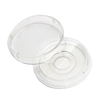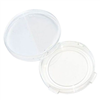

FluoroDish Cell Culture
Optical Grade Glass Bottom Culture Dishes For Imaging

Cover-glass bottom for observing and growing cells for imaging
- Optical quality glass bottom on petri dish offers better imaging quality (RI=1.525)
- Non-fluorescent glass so you can discern weaker signals
- Low sample volume for expensive chemicals
- Flat bottom optimizes heat exchange
- Less optical distortion and superior UV transmission
- Low cytotoxicity adhesive to ensure cells' survival
- Individually packed and gamma sterilized (supplied in a box of 100)
- Coated dishes available for better cell adhesion
- Blackwall dishes are available to block stray lights and reduce background noise
FluoroDish™ dishes provide exceptional imaging quality for many applications requiring the use of inverted microscopes such as high resolution image analysis, microinjection, and electrophysical recording of fluorescent-tagged cells. Taking advantage of WPI’s extensive experience with low toxicity adhesives, FluoroDish™ uses a specially formulated adhesive that is optically clear and durable with extremely low toxicity. The bottom glass has superior UV transmission: 30% transmission at 300 nm, compared to less than 7% for the most popular German glass. Stringent quality control ensures that glass thickness stays within the 0.17 ±0.01 mm range. Cited in 575 reference articles (in the NIH PubMed Central® alone), our optical grade, glass bottom culture dishes are unique in the marketplace and conform to strict quality control standards.
Improve Research Results
with FluoroDish Optical Grade Glass Bottom Culture Dishes

Get the highest quality images and video for your research with FluoroDish Cell Culture dishes. Their optical quality glass bottom is as thin as a coverslip, which ensures the least amount of distortions and excellent heat transfer without any of the autofluoresence issues so common with plastic petri dishes.
Choose the style that suits your application. For live cell imaging, embryo research, and life science researchers working with small sample volumes, the 35mm Fluorodish petri dish with a 10mm well (FD3510) is ideal. Researchers working with expensive chemicals or experimental drugs choose the FD3510. They are also an excellent choice for microinjection applications, because they are designed with the lowest access angle for easier insertion of a micropipette during cellular microinjection. Fluorodishes are also available in 35mm (FD35) or 50mm (FD5040) sizes for cell culturing applications. For better adhesion of neurons, try the 35mm Fluorodish that is coated with poly-D-lysine (FD35PDL).
Cited in 575 reference articles (in the NIH PubMed Central® alone), our optical grade, glass bottom petri dishes are unique in the marketplace and conform to strict quality control standards.
![]()
Benefits
When you need quality glass bottom cell culture dishes with less optical distortion, excellent UV transmission, low cytotoxicity and guaranteed sterility, order WPI FluoroDishes.
- Optical quality glass bottom of the petri dish for shorter working distances, larger numerical aperture and higher magnification
- Non-fluorescent glass so you can discern weaker signals
- Allows the use of immersion objectives
- Flat bottom optimizes heat exchange
- Less optical distortion and superior UV transmission
- Low cytotoxicity adhesive to ensure cells' survival
- Individually packaged and gamma sterilized
- Multiple sizes and designs to suit your application
- Optional black wall to minimize background fluorescence and light scattering
- Optional coatings used to improve cell adhesion, growth, and differentiation
- Dishes designed for low volumes or large growth areas
Optical Grade Glass Bottom for Exceptional Imaging Quality
FluoroDish™ dishes provide exceptional imaging quality for many applications requiring the use of inverted microscopes such as high resolution image analysis, microinjection, and electrophysical recording of fluorescent-tagged cells. Taking advantage of WPI’s extensive experience with low toxicity adhesives, FluoroDish™ uses a specially formulated adhesive that is optically clear and durable with extremely low toxicity. The bottom glass has superior UV transmission: 30% transmission at 300 nm, compared to less than 7% for the most popular German glass. Stringent quality control ensures that glass thickness stays within the 0.17 ±0.01 mm range. Cited in 575 reference articles (in the NIH PubMed Central® alone), our optical grade, glass bottom culture dishes are unique in the marketplace and conform to strict quality control standards.
Specially Formulated Low Toxicity Adhesive
FluoroDish™ optical glass bottom dishes use a specially formulated adhesive that is optically clear, durable and with extremely low toxicity. Tests by an independent laboratory have shown that the 96-hour survival rate of rat embryos typically exceeds 95% when kept in a FluoroDish™.
Multiple sizes
We have a 50 mm diameter petri dish and two types of 35 mm diameter petri dishes. An inner well is created within the dish by the glass bottom and the tissue culture grade polystyrene which forms the sides of the dish. They are individually packed, and gamma sterilized.
The 35 mm petri dish has outside dimensions similar to that of a Corning 35 mm petri dish and has ø23.5 mm glass window (FD35) or ø10 mm glass window (FD3510). Most heaters and perfusion adapters designed for the Corning 35 mm petri dish also fit this petri dish.
Clear Glass Bottom Dishes
Conventional plastic dishes and chambers limit the utility of the inverted scope for many applications, as thick plastic bottom requires a long working distance objective available only in lower magnifications. Each WPI dish has a flat (0.17mm thick) optical quality glass bottom, allowing the use of a much shorter objective working distance, larger numerical aperture (NA), and a higher magnification (up to 100x). The larger NA and higher magnification provide superior quality imaging for both classical and fluorescence microscopy. Higher effective NA yields brighter images for fluorescence and higher resolution in image analysis. The glass bottom permits the use of immersion objectives with a medium such as water, glycerin, or oil for the highest magnification possible. To optimize heat exchange, WPI’s glass-bottom dish is designed to be flush (flat) with the microscope stage or heating unit, therefore eliminating the air gap that exists with modified plastic dishes in which a glass cover slip has been inserted.
Coated Glass Bottom Dishes
Coated FluoroDish™ are used to improve cell adhesion, growth, and differentiation within the optical glass bottom culture dish.
WPI offers a range of coated 35mm dishes, including Collagen, Fibronectin, Poly-D-Lysine, Poly-L-Lysine, and Vitronectin. Coated culture dishes are useful in promoting cell adhesion to culture surface and can be used for cell attachment, cell expansion, serum-free cultures, and cancer research. Additionally, coated dishes allow for detailed observation of cellular process when doing high-resolution live cell imaging analysis. When doing cell adhesion assays, coated dishes facilitate studying cell-substrate interations. Coated culture dishes are suitable for microinjection experiments, too.
- Collagen is often used to promote the adhesion and growth of various cell types, including fibroblasts, endothelial cells, and epithelial cells
- Poly-L-Lysine enhances cell adhesion for neurons, glial cells, and other cell types
- Fibronectin is a high-molecular-weight glycoprotein of the extracellular matrix that binds to membrane-spanning receptor proteins called integrins
- Vitronectin is a glycoprotein found in the extracellular matrix and blood plasma
- Poly-D-Lysine utilized in experiments involving primary neuronal cultures and cell adhesion supports neurite outgrowth on PDL coated optical glass.
Black Wall Glass Bottom Dishes
WPI’s Blackwall FluoroDishes™ have low background fluorescence, making them ideal for live cell microscopy, as well as fluorescence microscopy, other high-resolution microscopy techniques, confocal microscopy, and inverted microscopy. They are also a good choice for applications like Total Internal Reflection Fluorescence (TIRF) and super-resolution microscopy. When working in a dark room, the black dishes allow for better visualization of the meniscus of the media. Blackwall FluoroDishes™ have a low rim and sidewall, making them suitable for micromanipulation or microinjection experiments.
Low Volume Glass Bottom Dishes Or Large Growth Areas
The 10 mm glass dish (FD3510) has low sidewalls for easy microelectrode access and low solution volume. The low microelectrode access angle is the lowest among all of 35 mm dishes on the market (very close to that of a 50 mm dish). The dish needs only about 115 µL to cover the bottom well, an important feature when using expensive drugs and chemicals.
The 50 mm petri dish (FD50) has a large growth area (35 mm well diameter), a low access angle for microelectrodes, and grips for easy handling.
Options
| Order Code | Description | Coating | Wall Colour |
| FD35-100 | FluoroDish, Glass Bottom, Clear Wall, 35 mm, 23 mm Well, Individually Packed, Sterile, 100/bx |
None |
Clear |
| FD3510-100 | FluoroDish, Glass Bottom, Clear Wall, 35 mm, 10 mm Well, Low Sidewall, Individually Packed, Sterile, 100/bx | None | Clear |
| FD5040-100 | FluoroDish, Glass Bottom, Clear Wall, 50 mm, 35 mm Well, Individually Packed, Sterile, 100/bx | None | Clear |
| FD35B-100 | FluoroDish, Glass Bottom, Black Wall, 35 mm, 23 mm Well, Individually Packed, Sterile, 100/bx | None | Black |
| FD3510B-100 | FluoroDish, Glass Bottom, Black Wall, 35 mm, 10 mm Well, Low Sidewall, Individually Packed, Sterile, 100/bx | None | Black |
| FD5040B-100 | FluoroDish, Glass Bottom, Black Wall, 50 mm, 35 mm Well, Individually Packed, Sterile, 100/bx | None | Black |
| FD35PDL-100 | FluoroDish, Glass Bottom, Poly-D-Lysine Coated, 35 mm, 23 mm Well, Individually Packed, Sterile, 100/bx | Poly-D- Lysine | Clear |
| FD35COL-100 | FluoroDish, Glass Bottom, Collagen Coated, 35 mm, 23 mm Well, Individually Packed, Sterile, 100/bx | Collagen | Clear |
| FD35FN-100 | FluoroDish, Glass Bottom, Fibronectin Coated, 35 mm, 23 mm Well, Individually Packed, Sterile, 100/bx | Fibronectin | Clear |
| FD35PLL-100 | FluoroDish, Glass Bottom, Poly-L-Lysine Coated, 35 mm, 23 mm Well, Individually Packed, Sterile, 100/bx | Poly-L- Lysine | Clear |
| FD35VN-100 | FluoroDish, Glass Bottom, Vitronectin Coated, 35 mm, 23 mm Well, Individually Packed, Sterile, 100/bx | Vitronectin | Clear |

Black Wall FluoroDish
Black Wall FluoroDish™ used in applications that require minimized background ...

Coated FluoroDish
Coated FluoroDish™ used to improve cell adhesion, growth, and differentiation<...

FD35-100
FluoroDish, Glass Bottom, Clear Wall, 35 mm, 23 mm Well, Individually Packed, Steril...

FD3510-100
FluoroDish, Glass Bottom, Clear Wall, 35 mm, 10 mm Well, Low Sidewall, Individually ...

FD5040-100
FluoroDish, Glass Bottom, Clear Wall, 50 mm, 35 mm Well, Individually Packed, Steril...




Request
Catalogue
Chat
Print